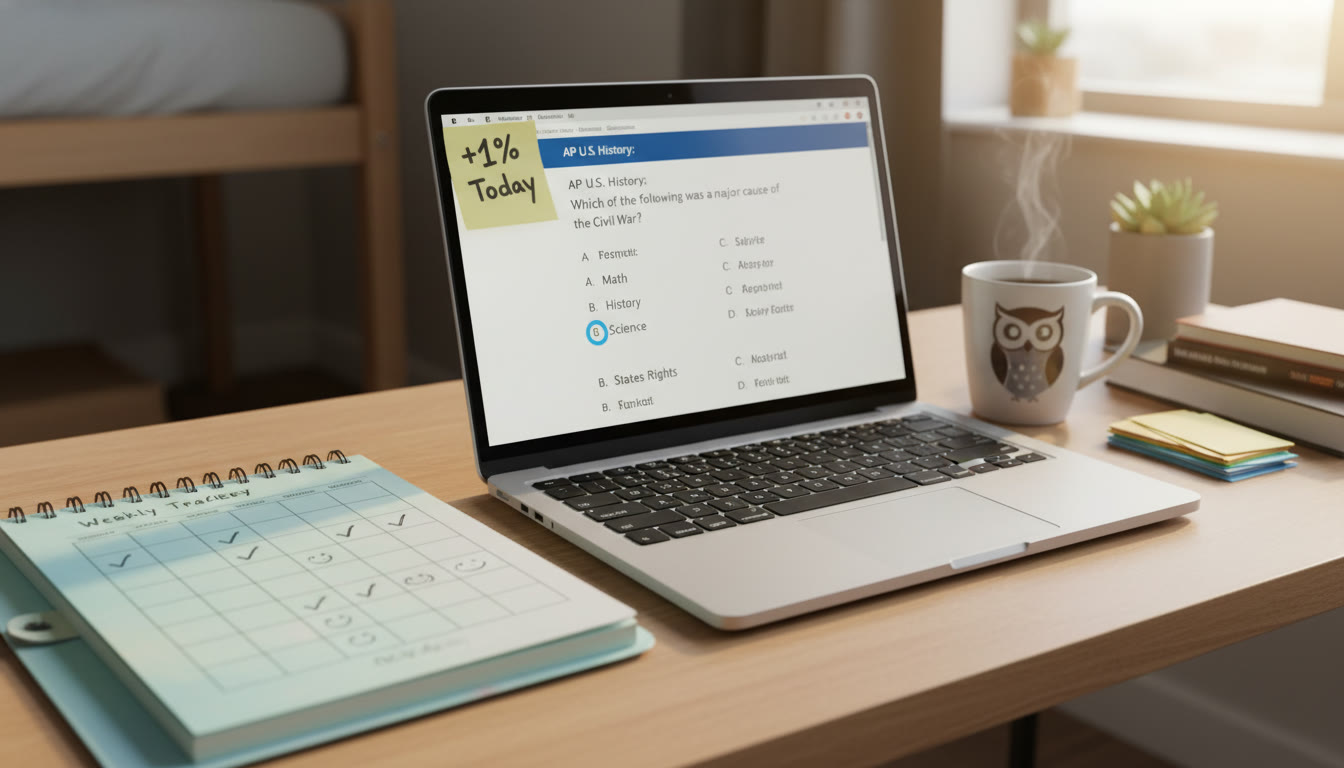The 1% Rule: How Tiny Improvements Add Up—Especially for AP Students
Picture a staircase where each step is just a hair higher than the last. If you climb that staircase consistently, after a year you’re on an entirely different floor. That’s the magic of the 1% Rule: tiny, repeatable improvements stacked over time. For AP (Advanced Placement) students juggling school, extracurriculars, part-time jobs, and a life outside of test prep, the 1% Rule isn’t a shortcut—it’s a sustainable roadmap.

Why the 1% Rule Works Better Than Last-Minute Sprints
We’ve all seen the all-nighter approach: long bursts of cramming followed by exhaustion and fragile recall. The 1% Rule says something different. Instead of trying to learn everything in one panicked session, you commit to improving just a little each day—1% better than yesterday. That steady accumulation leads to deeper understanding, stronger retention, and far less stress.
Three science-backed reasons the rule works:
- Spacing strengthens memory: small, repeated practice builds durable knowledge more efficiently than massed practice.
- Micro-goals reduce friction: when tasks are small, starting is easy and consistency follows.
- Compounding effect: 1% daily improvement compounds; it looks small at first but becomes substantial.
Real-World Context: AP Subjects Are Built for Incremental Wins
AP courses—whether AP Calculus, AP Biology, AP U.S. History, or AP Literature—present large bodies of knowledge. But each concept can be broken down into micro-skill units: a theorem, a lab technique, a historical argument, or a poem annotation technique. When you apply the 1% Rule, you target one micro-skill at a time: focus on that one derivative technique, one conceptual connection, or one primary source each day. Over weeks and months, those micro-skills compile into readiness for exam-level thinking.
Designing a 1% Rule Study Plan for AP Students
Designing your plan means translating “1% better” into concrete actions. Here’s a flexible blueprint you can adapt by subject, exam date, and your weekly schedule.
Step 1: Pick Your High-Impact Micro-Habits
- AP Math (Calculus/Statistics): Solve one new problem type each day; review one solved problem’s key steps.
- AP Science (Biology/Chemistry/Physics): Summarize one concept in your own words and draw a simple diagram.
- AP History (U.S./Euro/World): Read one primary source paragraph and write a two-sentence analysis.
- AP English (Language/Literature): Annotate one poem stanza or one paragraph for rhetorical devices daily.
Step 2: Timebox It
Small habits only work if they fit your life. Rather than promising three hours, commit to a 20–40 minute focused session daily. That’s enough to make meaningful micro-progress without crowding your day.
Step 3: Track Progress (Make It Visible)
Use a simple tracker—checkmarks on a calendar, a quick digital app, or a one-line log in your notes app. The visible streak motivates you and helps you adjust: if you miss several days, shorten the task, don’t abandon it.
Example Weekly Plan: AP Biology (1% Rule in Action)
This sample shows how tiny actions map into measurable gains over one week. Use it as a template and tweak according to your exam timeline.
| Day | Micro-Task (20–40 mins) | Why It Helps |
|---|---|---|
| Monday | Summarize one process (e.g., cellular respiration) in 6 sentences + sketch. | Condenses knowledge and leverages dual coding (text + image). |
| Tuesday | Do 5 practice MCQs on energy pathways; review answers. | Targets retrieval and identifies misconceptions. |
| Wednesday | Explain a concept aloud to a friend or a voice memo (2–3 mins). | Forces clarity and shows gaps in articulation. |
| Thursday | Annotate a short primary paper figure or data table. | Builds data-interpretation skills key to FRQs. |
| Friday | Complete one practice FRQ part and self-grade with rubric. | Develops exam-writing habits and timing awareness. |
| Saturday | Mixed practice: 10 MCQs across units; quick review of missed topics. | Improves retrieval across contexts and reduces test-day surprises. |
| Sunday | Rest + 10-minute plan for next week; reflect on wins and friction. | Recovery and meta-cognition: learning how you learn best. |
How Much Does 1% Really Add Up?
A 1% daily improvement compounds: (1.01)^365 ≈ 37.8. That’s a useful mental model rather than a literal claim—you won’t necessarily be 38 times smarter in a year—but it captures the power of continued incremental effort.
Concrete Techniques to Make 1% Work for You
Technique 1: The Mini-Review
At the end of any study session, spend three minutes writing the single clearest idea you learned. This tiny reflection cements the core takeaway and creates a bank of flash-review prompts you can revisit in minutes a day.
Technique 2: The Problem-Rich, Time-Poor Approach
When time is short, prioritize active problems over passive reading. Ten minutes of tackling a fresh AP problem trumps thirty minutes of passive notes. Over weeks, this behavioral shift alone yields large gains.
Technique 3: The Two-Minute Repair
After a practice test, identify the three smallest adjustments that would have made your score higher—maybe labeling a diagram better, answering with a sentence starter, or finishing two fewer questions early. Commit to practicing those small fixes daily until they become automatic.
Technique 4: Spaced Micro-Quizzing
Create 30–60 second micro-quizzes for yourself on flashcards or note-app reminders. These work brilliantly for vocabulary, formulas, and key dates. Short, frequent recall beats long, infrequent reviews.
Examples and Comparisons: 1% vs. Other Approaches
Compare three typical strategies and how the 1% Rule stacks up:
- All-nighter cramming — High short-term gain, low retention, burnout risk.
- Weekly marathon study — Better retention than cramming, inconsistent momentum.
- 1% daily improvement — Lower daily effort, highest cumulative retention and well-being.
The 1% approach also integrates well with targeted interventions: if you find a recurring weakness, scale the micro-habit for that topic to 2–5% improvements over a concentrated period, then return to the 1% maintenance rate.
Measuring Progress: Simple Metrics That Matter
Don’t drown in data. Pick a small set of metrics that give you true signals:
- Accuracy on practice MCQs (tracked weekly by topic).
- Time to complete an FRQ or free-response subsection.
- Number of micro-habits completed (calendar streak).
- Qualitative confidence rating per unit (scale 1–5).
One practical monthly checkpoint: take a realistic practice test under timed conditions and compare core metrics (score, timing, and most-missed topic) to the previous month. Small steady improvements in these metrics are the real evidence of compounding success.
How Personalized Tutoring Amplifies the 1% Rule
Tiny improvements stick faster when someone helps you pick the best micro-steps. Personalized tutoring—like Sparkl’s 1-on-1 guidance—can accelerate the process in several natural ways:
- Tailored study plans that prioritize your weakest micro-skills, so your 1% efforts target what matters most.
- Expert tutors who model efficient study techniques and give immediate, actionable feedback that would otherwise take weeks to discover on your own.
- AI-driven insights that help spot patterns in mistakes and suggest the highest-leverage micro-changes—saving study time and maximizing score gains.
Think of Sparkl’s role not as doing the work for you, but as a guide who helps you choose the right 1% steps and keeps you accountable in a way that fits your life.
Example: When a Tutor Makes One Small Change that Multiplies Gains
Imagine a student who misses points on AP U.S. History FRQs for weak thesis statements. A tutor helps them refine a 2-minute thesis template and assigns a one-question daily drill to use it. That tiny daily correction can flip several FRQs from mediocre to strong, which in turn can move section scores considerably.
Overcoming Common Obstacles
Obstacle: “I Don’t See Immediate Results”
Patience is part of the system. Keep a short log of wins (even small ones) and compare weekly snapshots instead of daily moods. If progress stalls for more than two weeks, revisit habit size—shorter tasks, clearer metrics.
Obstacle: “My Schedule Is Chaotic”
Design micro-habits that fit the chaos. Fifteen minutes before practice, a commute flashcard session, or a quick review during a lunch break—consistency beats duration. If needed, involve a tutor or study partner for accountability and schedule anchors.
Obstacle: “I’m Bored”
Variety is the secret weapon. Rotate between problems, essays, and active recall. Gamify small wins—earn a fun reward after five consecutive days of micro-practice.
Sample 30-Day Micro-Plan (AP Calculus Focus)
Below is a compact plan built on the 1% Rule: daily micro-tasks designed to build core calculus fluency over 30 days.
| Week | Daily Micro-Task | Primary Goal |
|---|---|---|
| 1 | 10-minute review of derivative rules + solve 2 derivative problems. | Foundational fluency in differentiation. |
| 2 | 10-minute limits practice + one conceptual explanation aloud. | Conceptual clarity for continuity and limits. |
| 3 | 10-minute integral practice + one application problem. | Build anti-derivative intuition and area interpretation. |
| 4 | Mixed review: 2 MCQs and one free-response prompt (timed). | Test skills under light pressure and refine pacing. |
When to Scale the 1% Rule Up or Down
Scaling is pragmatic. If you’re consistently hitting micro-goals and still feel behind on a topic, temporarily increase the daily goal to 2–5% improvements for a concentrated two-week push. Conversely, if you miss your micro-habit more than twice in a row, shrink it—smaller steps restore momentum.
Stories of Small Changes That Led to Big Wins
Students report surprising wins from tiny actions: a daily two-sentence paragraph improved essay structure; five minutes of spaced vocabulary improved reading comprehension; a single tutor tip on how to annotate transformed a slow reader into a timed-test efficient one. The pattern is the same: micro-action, consistent repetition, feedback loop, and gradual mastery.
Putting It All Together: Your Personal 1% Checklist
- Choose one micro-habit tied to a high-leverage AP skill.
- Timebox it to 20–40 minutes or less; shorter if needed.
- Track it visibly and reflect weekly.
- Use micro-quizzing and spaced repetition.
- Seek targeted feedback—consider a few sessions of personalized tutoring (for example, Sparkl’s 1-on-1 guidance) to refine technique quickly.
- Adjust size: scale up briefly when needed, scale down to recover momentum.
Quick Motivation: A Note to You
It’s tempting to wait until you have “more time” or “more clarity.” The truth is that the path to AP success is rarely dramatic; it’s mostly quiet, steady, and cumulative. Commit to making one small, sensible improvement today—no fireworks required—and see where you are in a month.

Final Thoughts: Consistency, Not Perfection
The 1% Rule is kind to ordinary lives. It acknowledges that you are a student, a friend, maybe an employee, and not a test-prep machine. Micro-habits respect your time and your energy while delivering cumulative power. Paired with deliberate practice, smart metrics, and occasional personalized guidance—such as short bursts of expert tutoring from services that offer tailored study plans and AI-informed insights—you’re not just preparing for an exam. You’re building study skills, resilience, and a habit system that serves you long after AP scores are posted.
Start small. Start today. Improve a little, and let compounding do the rest.























No Comments
Leave a comment Cancel